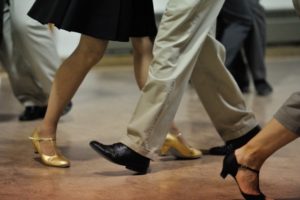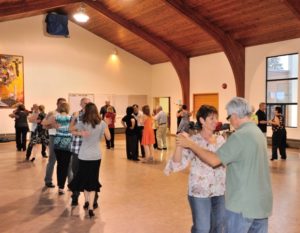Online Content
May We Have This Dance?
Sabrina’s Dance Instruction celebrates 30 years
January, 2017
Sabrina Thievin is always moving and always evolving through dance. One doesn’t run a successful dance school for 30 years and not learn a thing or two about business, teaching and, most importantly, relationships. Early on,

Sabrina realized that “everyone can learn to dance” and it’s been her mantra since she began teaching in 1987. Her job as an instructor is finding out how you learn and making sure you understand.
Sabrina has been dancing since she was a young girl and has been teaching in St Albert since 1992. With all these years of experience, she has learned to adapt how she teaches her students. She says that to be a great dance instructor—or any type of instructor—you have to listen to your students, figure out how to teach them so that they understand and you have to connect with them. She does this through several different avenues: getting feedback from her students, taking personal growth courses and being a good listener to verbal and non-verbal communication.
Because everyone learns differently, she discovers each student’s learning modality: audio, visual or kinesthetic. And with group dance lessons, she has to use all three so everyone understands. Sabrina explains, “I use words for counting beats and describing where I’m going when I’m teaching. I demonstrate the steps solo and with a partner, which is the visual. It’s kinesthetic because you have to do it.” Some students have attended her classes with some trepidation because of previous bad dancing experiences; others have been told to quit because they’ll never learn to dance. Sabrina tells these students “it’s not that you can’t dance; it could just be that the instructor didn’t know how to teach you or was teaching you the wrong dance.” She firmly believes that everyone has a dance, and this especially

is realized when she teaches. Some people who may have trouble with rhumba may find the waltz easy. You just have to find your type of dance. And Sabrina likes a challenge. If a student is still struggling, she’ll do her best to find a way for you to succeed.
Along with adapting to students’ learning modalities, Sabrina uses what she learned from a personal-growth course about masculine and feminine energies. Masculine energy, according to Sabrina, is where you process everything through your head first, understand it and do it. Feminine energy is where you process it through your body first, using emotion first to see if it feels good or bad, understand it and do it. Not all men use the masculine-logic energy, just as not all women use emotion to understand what they’re being taught. But these masculine and feminine energies made a lot of sense to Sabrina, and she constantly uses that approach when she teaches.
Over the years, Sabrina has noticed that some women feel self-conscious on the dance floor. She created a women’s group called Groovy Goddess about eight years ago. It’s not just a dance class, Sabrina says “…it’s helping women be at home in their own bodies and to embody themselves to music on the dance floor whether it’s for their own personal pleasure, putting themselves out there or connecting with another person.” Groovy Goddess is just one way Sabrina gives back to the community.
One of her students once said to her, “you dance because you love it; you teach because that’s who you are.” To her, this made a lot of sense. She feels it’s important to have those connections with her students, and she hopes her students want to connect not only with her but with their fellow students. There may be an occasion that brings you to taking dance lesson, but there’s always a part of you that wants to move, there’s always a part of you that wants to connect with another person. Dance is a way of having all of that.










